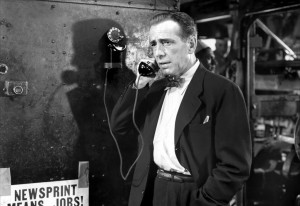 You may have heard the old joke about the guy who cleaned up after the elephants in the circus and complained to his friend about the long hours, the low pay and the dirty work. When his friend asked him why he didn’t just quit, the guy responded, ”What, and leave show business?”
You may have heard the old joke about the guy who cleaned up after the elephants in the circus and complained to his friend about the long hours, the low pay and the dirty work. When his friend asked him why he didn’t just quit, the guy responded, ”What, and leave show business?”
Substitute ”newspapers” for ”show business” and you’ve basically got the life of a print journalist. You’ll notice I didn’t have you substitute anything for ”clean up after the elephants.”
But that’s not the only connection between newspaper work and show biz. Reporters and editors have been characters in movies for as long as there have been movies, and for a good reason: because most screenwriters are disgruntled former reporters. Still, the fact that we’re in a profession that could actually be the subject of an entire feature film (like detectives! and spies! and Batman!) may, on some days, be the only thing keeping us here. (Not me. Other people.)
Personally, I can’t overstate how happy I was to find my favorite old newspaper movie, Richard Brooks’ Deadline USA (1952), pop up on cable recently. This is the film where the editor is played by Humphrey Bogart — Humphrey Bogart! — in a natty fedora, bow tie and overcoat. He stands up to mobsters, decries the rise of tabloid journalism and is forced to watch as his paper is shut down due to shrinking revenues. So it’s at least one-third realistic.
[youtube id=”FgdE-qPv6kw” width=”600″ height=”350″]The flip side of the Bogart coin when it comes to cinematic editors is of course Cary Grant in Howard Hawks’ His Girl Friday (1940) — for Grant’s Walter Burns, journalistic ethics aren’t important so much as getting the story, selling papers, engaging in rapid-fire, whip-smart repartee with Rosalind Russell as reporter Hildy Johnson and being, well, Cary Grant. It’s worth noting that ”Friday” was an update of that other newspaper classic The Front Page, a play that was made into several films featuring a male Hildy Johnson, none of whom could rock a pencil skirt and high heels like Russell. (Well, except maybe for Jack Lemmon.)
[youtube id=”_DKYR58HHSE” width=”600″ height=”350″]Even Jimmy Stewart (arguably the third member of the classic leading-man triumvirate with Bogart and Grant) donned the reporter’s cap in Henry Hathaway’s Call Northside 777 (1948). Unfortunately it’s a little too sincere for its own good — it’s hard not to prefer Stewart’s slightly less straight-and-narrow reporter (for ”Spy magazine,” yet) in George Cukor’s The Philadelphia Story (1940), which introduced the journalistic truism that socialites love reporters. It’s true, they do.
[youtube id=”c0fMEBS7au0″ width=”600″ height=”350″]Sometime between the black-and-white era and modern day, though, newspaper journalists in the movies lost some of their leading-man sheen — the exception of course being Robert Redford and Dustin Hoffman in Alan J. Pakula’s All The President’s Men (1974). This was mainly because they were playing real-life journalistic heroes Woodward and Bernstein, and they were Robert Redford and Dustin Hoffman.
Not that newsmen weren’t still cool — was there ever a reporter who wouldn’t want to be Chevy Chase’s Irwin M. Fletcher from Michael Ritchie’s Fletch (1985)? He gets to hang out at the beach, pretend to be other people, like Ted Nugent and John Cocktosten, order a steak sandwich (and a steak sandwich) and put it on the Underhills’ bill, and, most importantly, doesn’t take notes.
[youtube id=”2bx4g-8PY9Q” width=”600″ height=”350″]Most people who actually work in newspapers point to Ron Howard’s The Paper (1994) as the best modern newspaper flick, and it’s hard to argue — I’m pretty sure the Randy Quaid character has been about two desks away from me for the last 20 years. But two of my favorite portrayals of newspaper reporters are slightly less grounded in reality, and yet somehow make complete sense.
[youtube id=”c1Aza_OyeEE” width=”600″ height=”350″]The first is the team of Kermit, Fozzie and Gonzo (talk about classic triumvirates) in Jim Henson’s The Great Muppet Caper (1981) — Kermit and Fozzie play twin brothers who happen to be ”crack investigative reporters for The Daily Chronicle” and Gonzo is their intrepid photographer, who takes a picture of a chicken instead of a jewel heist in progress. That sound you just heard is thousands of journalists nodding their heads in recognition.
But my new favorite movie newspaper man (boy?) has got to be Tintin from Steven Spielberg’s The Adventures of Tintin (2011). Have you seen it? He travels the world, never seems to have a deadline or an editor or even see the inside of a newsroom, and doesn’t hesitate to, in a pinch, shoot at people.
Sure beats cleaning up after the elephants.
[youtube id=”9ua_4ajpP58″ width=”600″ height=”350″]




Comments